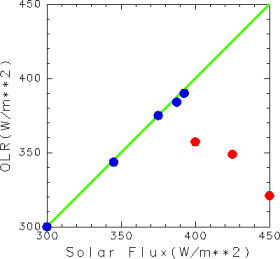|
In order to obtain critical value of solar constant at which the
thermally runaway state emerges, the global mean incident solar
flux and global mean OLR for all experiments is plotted in
Figure 1. The values of OLR shown in the plot are the
time-averaged global mean values from Day 950 to Day 1000,
except for the S1600 experiment (in which the global mean values
of incident solar radiation flux are 400 W/m2). For S1600, the
value is the time-averaged value from Day 1950 to Day 2000.
When the value of solar constant is 1570 W/m2 (global
mean incident solar influx is 392.5 W/m2) or less,
OLR is almost equal to the incident solar radiation flux and is
regarded as having reached an equilibrium value. In contrast,
when solar constant is 1600 W/m2 (the global mean
incident solar influx is 400 W/m2 ) or more, OLR
falls below 350 W/m2. In experiments S1600 and S1700,
the values of OLR gradually decrease with time, whereas surface
temperature increases with time (not shown in plot). In all
cases where S ≥ 1600 W/m2,
the system failed to reach an equilibrium state and the thermal
runaway state emerged. Therefore, it can be concluded
that the solar constant at which the
thermal runaway state emerges (runaway limit) is slightly below
1600 W/m2.
|
 Figure 1: Global mean incident solar flux and
global mean OLR for all experiments (W/m2). The blue
points show the results in which the system reaches an
equilibrium state and the red points show those in which the
thermally runaway state emerges. Note that in all cases where
S ≥ 1600 W/m2 the system
failed to reach an equilibrium state. As a result, the values of
OLR of these case shown in this figure do not have physical
meaning, because OLR gradually decreases with time. For
experiment S1600, the value at Day 2000 is used to show a
clearly the runaway limit value. To view the results of all
experiments, click the corresponding blue and red points on the
figure (Appendix G).
Figure 1: Global mean incident solar flux and
global mean OLR for all experiments (W/m2). The blue
points show the results in which the system reaches an
equilibrium state and the red points show those in which the
thermally runaway state emerges. Note that in all cases where
S ≥ 1600 W/m2 the system
failed to reach an equilibrium state. As a result, the values of
OLR of these case shown in this figure do not have physical
meaning, because OLR gradually decreases with time. For
experiment S1600, the value at Day 2000 is used to show a
clearly the runaway limit value. To view the results of all
experiments, click the corresponding blue and red points on the
figure (Appendix G).
|